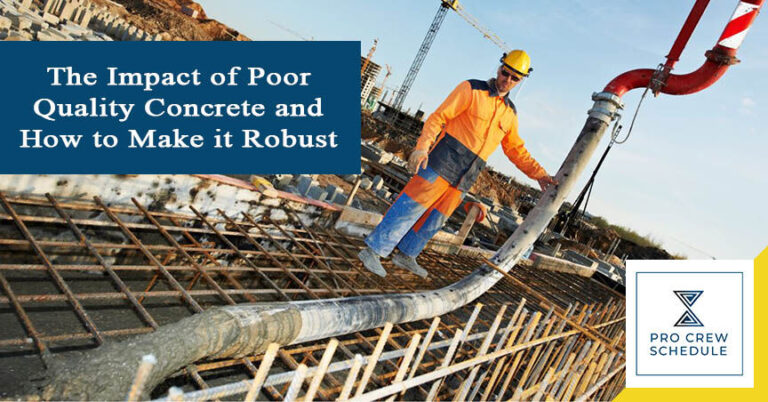Quality construction projects are made from quality work and materials. In all types of infrastructure, there is one building material that is common and composes the majority of the bill of material – concrete. Managing construction is never without a little bit of tons worth of concrete, making it the most indispensable material on-site, no matter how small or big a project is.
Concrete has been used in the construction industry for many centuries, showing how reliable and strong it is. However, the quality of all concrete is not the same. Throughout the years, there have been a lot of developments in the construction industry that also affected its materials. Progress comes with new concrete options, and contractors are now encouraged to be more selective in choosing this important building material.
Which brings us to the question- how can a contractor choose the best concrete for their projects? What is the cause and impact of poor-quality concrete? How can good quality management lead to more successful projects?
What Causes Low-Quality Concrete?
Low-quality materials lead to low-quality output.
Using incorrect proportions of cement or not following a design mix that has been batched properly for its application usually results in sub-par concrete. Unfortunately, some concrete suppliers will cheat and cut their production quality to make a bigger revenue, so they use cheap raw materials with poor workmanship when manufacturing their concrete.
Another cause for poor quality concrete is adding recycled materials to the mix. Even though some companies consider it as a way of boosting their sustainability and green credentials, including a high percentage of recycled components in a concrete mix is detrimental to its quality, often leading to below-standard strength and durability.
What are the Warning Signs of Low-Quality Concrete?
Poor quality concrete is typically easy to detect, as signs manifest externally. While concrete inspections are carried out by pros, there are three early warning signs that you can watch out for before it’s too late:
- Honeycombing: A pattern in the concrete surface that occurs when too much volume of concrete has been placed in one area, or it has not been compacted correctly.
- Cracks: Common in poor-quality concrete, these can appear in various forms and be connected to different causes.
- Cold Joints: A sign that shows when fresh concrete is poured next to partially hardened concrete, causing a weak bond and weak strength.
How Can You Make Good Quality Concrete Works?
A major and critical part of managing construction projects is managing quality – where a Quality Management System (QMS) comes into the picture. QMS is a set of guidelines on quality management in concrete construction. Implementing these guidelines will help your business improve the quality of concrete works by implementing quality processes, functions, and tasks.
The quality of a construction project will be dependent on the start-to-end tasks involved in the whole project. From the procurement of construction materials until close out of the completed project. Every step between these phases must be performed with utmost quality and detail. Deviation from this will lead to failure and penalty issues to the project manager in charge. This is why it’s critical to follow tested and certified guidelines when doing concrete work. With good crew schedule management, these guidelines will be easy to implement on the worksite, making concreting activities easier.
How to Check the Quality of Concrete in Construction?
Concrete quality plays a critical role in the construction field as it can either solidify or break any infrastructure. The strength parameters of concrete, such as durability, resistance, and bearing strength, and external factors, such as water, wind, or snow, can affect the quality of concrete. Generally, the quality of concrete is inspected and checked in the different stages of the concreting process.
To ensure that you and your team can implement the following activities, you can input and schedule the steps in a construction scheduling software like Pro Crew Schedule. This way, you can have peace of mind that the quality of your concrete work is never at stake.
1. Pre-Construction Quality Checks
There are two quality checks to conduct in this construction stage:
- Verification for parameters and methodology regarding excavation, structural forms, foundation, architectural, etc.
- Technical test to confirm the specifications on concrete mix materials (i.e., on cement, aggregate, and even water)
2. Cement
Cement quality is verified by performing compressive and tensile strength tests on cement specimens, whether spherical or cube. For more effective cement control, the following parameters must be followed:
- Initial test must be done at least once for each area and subsequently once for every two months
- Concrete must be protected from moisture
- Mixture be rejected if large lumps are found in cement bags
- Concrete should be retested after three months in storage if long storage is unavoidable
3. Aggregate
Concrete aggregates should conform to the given amount as per standard specifications. The quality of concrete is easily affected by various physical and mechanical properties of aggregate, such as shape, durability, grading, water absorption, specific gravity, etc. These properties of aggregated should undergo testing before being used for concrete mix on a construction project.
The quantity of organic impurities and harmful materials should also be tested. Bulking of sand is also critical, as it gives wrong results when a volume batching is conducted. It increases the cement ratio, which is indirectly proportional to strength. For effective control and testing of aggregates:
- Testing must be done first to check the quality of the source
- Must subsequently be tested once or twice a day for moisture content
- Allowance should be made for moisture content
4. Water
Apart from concrete and aggregate, the quality of water should also be checked to see if it conforms to the given standard. Chemical analysis shall be performed for approval of the water source. In case of identified impurities, water storage should be done for some time to allow them to settle down.
To better check the water quality, small concrete specimens are tested to determine how water affects the hardened concrete.
Here’s a rule of thumb: The average of 28 days compressive strength of three concrete cubes/cylinders mixed with the water target to be used shall not have less than 90% of the average strength of another three concrete cubes/cylinders prepared with distilled water.
5. During Concreting Monitoring
Strict supervision during concrete manufacturing is necessary for all concreting activities like batching, transporting, mixing, compacting, laying, and curing. Following careful precautions should be taken during the concreting operation, with the following guidelines:
- The concrete mix should be formulated in the laboratory with the same raw materials that will be used on site. After which, the concrete should be batched by weight. If this is proven difficult, volume batching may be approved through proper supervision in the presence of a concrete engineer in charge.
- Before missing the concrete, the mixer to be used should be charged to its full capacity. After that, raw materials should be fed into the mixer in proper sequence. Mixing time should not be less than 2 minutes in any scenario. The recommended speed of the mixer should range from 15 to 20 revolutions per minute. Moreover, segregation should be avoided while unloading the mixed concrete from the mixer.
- Vibrators should always be used as a tool for compacting concrete to any surface, and the insertion spacing between internal vibrators must not be more than 0.6 m. The internal vibrators should be drawn out slowly to ensure there are no holes in the process of compacting concrete. The vibrator frequency should strictly not be less than 7000 cycles/minutes.
- Concrete workability is a critical component of concrete while it is still fresh. Compaction factor tests or slump tests must be carried out to verify the workability of concrete. At least three tests should be performed for every 25 m3 of concrete on-site.
- The concrete formwork should be shaped or molded according to the final form of the structure and must be checked before concreting begins. The interior of concreting forms should be cleaned and oiled properly, and forms should be removed after the curing time.
- Curing should be completed following a specified period so concrete develops up to its required strength. Concrete should be covered with plastic as soon as it becomes hard.
6. Post Concreting Checking
Once the concrete is laid, compacted, and cured, compression tests are done on the cubes of the same concrete mixture. For standard concrete, cubes are made out of the concrete mix made at the work site. The hardened cement has to be checked for dimensions, shapes, and sizes in alignment with design specifications. The general surface appearance of compacted concrete should also be checked. Checking of concrete strength is normally done in cube or cylinder samples after 28 days.
Key Takeaway
Quality concrete makes quality buildings, that is why it is the construction material that is shown the utmost importance in quality management. With the right parameters, specifications, and methodology, quality concrete is not hard to achieve.
You can also adapt construction scheduling software like Pro Crew Schedule to help you and your team schedule all the needed guidelines during your concreting works. This way, you can ensure that all steps from start to finish are sequenced properly. You can incorporate the delegation of tasks to your team in this software to provide an efficient and seamless operation.







